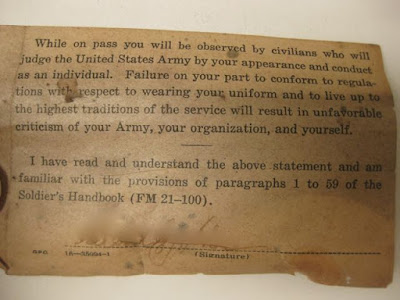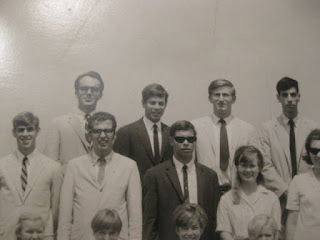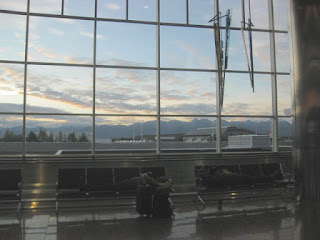It's with a heavy heart that I have to conclude that UA President finalist Jim Johnsen has padded his resume. In a section labeled "Selected Publications" there are three items listed. None of them can be legitimately called a 'publication.' While this may seem trivial to some, in the academic world where he has spent a good part of his career and where this job would be, publications make or break a faculty career.
Dr. Johnsen, according to his resume, has never been in a tenure track position, so actually having publications is not something that would have been required of him. Sure, having some publications might enhance his standing, but they aren't necessary. My concern is that he padded his resume to make his accomplishments look like more than they were. And while this section was labeled 'Selected Publications,' implying that there are other works that would be legitimately called publications in an academic setting, there aren't. The rest of this post will give the details of the documents identified in the resume and discuss the issues of academic publications and resume padding.
Finalist Announcement
When the one finalist for the UA president was announced, I was partly surprised by who it was - someone I had interacted with in my role as a faculty union grievance representative - but even more so by the fact that there was only one candidate. There was a search in 1998 that resulted in only two candidates, but the 1990 and 2010 searches had four and three respectively.
The Board of Regents webpage had a
link to the resume. As I looked through it I saw there were three items listed under "Selected Publications." They were all topics that related to University of Alaska labor relations, my connection to Johnsen.

So I googled to find them. I got nothing.
The 'Publications'
I called the UAA Consortium library reference desk and the librarian said she had been looking unsuccessfully herself. She suggested I contact the National Center for the Study of Collective Bargaining in Higher Education, where
"The Restructuring . . ." piece was supposed to be in their 2000 proceedings. (I had already been to their website, but hadn't done more.) So I called and asked if they had a copy. Michelle told me that they had copies of all the proceedings online, but that the organization had been in turmoil for about five years and
their collection went from 1972-1999 and then 2006-the present. The years 2000 - 2005 are listed as unavailable.
The next day my inbox had two copies of that paper. Both the people I'd talked to had contacted Jim Johnsen. The National Center sent me a copy they got from Johnsen and Johnsen himself sent me a copy with a promise to send the other two when he got home over the weekend, which he promptly did.
The first one - "The Restructuring . . ." - looked like a rough draft, partially in outline. Something that one might use as notes for a presentation. I called the National Center for the Study of Collective Bargaining in Higher Education back and asked about their proceedings; were they refereed or edited? I was told they were, at best, loosely edited for typos, but were basically presenters' papers printed out for conference attendees. Some conferences publish peer reviewed and edited conference proceedings. That wasn't the case here. And, the year that Johnsen presented this paper, the organization was in turmoil. The Center didn't have any copies of proceedings for that year. I later emailed Johnsen to see if he had a copy of the proceedings and he didn't. That doesn't mean something wasn't printed up that year, but neither the Center nor Johnsen has copies.
Then I got the other two papers.
The Essential Elements of a Faculty Collective Bargaining Agreement in Higher Education says "30 September 2008 draft" at the bottom of each page. In the text it says, "In this chapter . . ." but the citation didn't include the name of a book. This was clearly not a publication.
Innovation in Faculty Collective Bargaining is another conference presentation, but not a publication.
So I emailed Jim Johnsen and asked:
1. “The Essential
Elements of A Faculty Collective Bargaining Agreement in Higher
Education” Is there an actual published version of this? It says
Chapter and it says “draft” so I was wondering.
2. "Innovation in Faculty Collective Bargaining" - This says
“Presented at” and begins, Thank you. Good morning. Is there a
published version of this somewhere?
3. “The Restructuring of the University of Alaska System” - This
mentions Proceedings. Given the nature of the paper - lots of outline -
I’m assuming this was not peer reviewed? Was this anything more than
all the papers at the conference were bound for
attendees? Do you have a copy of the proceedings?
4. Your resume has these documents in a section called “Selected
Publications.” Are there additional publications as that suggests? Can
you give me links to them?
Jim Johnsen replied quickly:
"Happy to clarify, Steve.
"Elements" was written for a book, edited by Dan Julius, in faculty
bargaining. Last I heard (several years ago) it was published by some
academic press. Not sure of its status.
"innovations" was a presentation at the CUNY higher education
collective bargaining conference that I was told would be included in
the proceedings of the conference. I refer you to CUNY for those papers I
presented there over the years that were in the
conference proceedings.
As to other papers, I gave UA all the papers I managed to hold onto through numerous personal and job moves over the years."
I don't know of any faculty member who doesn't know if the chapter he wrote got published or not. Maybe if they've got 30 chapters in various books they might not remember about one or two of them, but if it's your only publication, I'd think you'd remember for sure. So I checked further.
I quickly found an email address for Dan Julius and asked him if the book had ever been published. He also wrote back quickly:
"Good day. What Dr. Johnsen says is true. He did write that chapter and
it was accepted for the book. The book has not yet been published due to
a variety of reasons having to do with the editors, one of whom is
myself. So the book has not been published yet, if it is, Jim's chapter
will be included. I hope this helps.
Dan Julius"
So, it hasn't been published and 'if it is' Jim's chapter will be in it.
Does it matter? Publications
The tenure and promotion process in universities is excruciating for most faculty. The worklife of a college professor these days is much more stressful than it was in the recent past even, and for many, particularly mothers, it can be impossible. (For
example or
example 2) In UAA tenure reviews all the documents are scrutinized by the chair, by the college promotion and tenure committee, by the dean, by the campus wide committee, the provost, and then the chancellor. The decisions can end someone's career. Of the three parts of the faculty workload - teaching, research, and service - the most difficult for the majority of faculty, in teaching institutions like UAA, is research because research involves long-term projects that have to be squeezed out on top of the short term demands of teaching and service activities. In some departments the criteria are vague and in other departments they are listed fairly clearly, such as "at least X peer reviewed articles or book chapters and Y presentations."
From Wikipedia:
Academic publishing is the subfield of publishing which distributes academic research and scholarship. Most academic work is published in academic journal article, book or thesis
form. The part of academic written output that is not formally
published but merely printed up or posted on the Internet is often
called "grey literature". Most scientific and scholarly journals, and many academic and scholarly books, though not all, are based on some form of peer review
or editorial refereeing to qualify texts for publication. Peer review
quality and selectivity standards vary greatly from journal to journal,
publisher to publisher, and field to field.
While different disciplines define their publications differently, by no stretch of my imagination, do the documents listed under 'Selected Publications' fall into the category of publications. These are conference presentations, the first of many steps toward publication.
Does It Matter? Enhancing One's Resume
From CNN article "Resume Padding: Inconsequential or Inexcusable?":
"It may sound crazy. Why would a high-ranking executive lie
about his or her credentials, especially now, when all it takes is a
quick phone call or Internet search to verify information?
Yet
it happens more often than you might think. From a white lie about time
spent as a customer service rep to a whopper about earning an MBA,
résumé padding occurs regularly across industries, experts say. In a
2010 survey of 1,818 organizations, 69% reported catching a job
candidate lying on his or her résumé, according to
employment screening service HireRight."
The 2012 article goes on to ask readers what they think should happen to the then newly hired Yahoo CEO Scott Thompson. A dissident shareholder had pointed out that Thompson's resume said he had BA degrees in computer science and accounting. Many called for his resignation, others defended him.
"Thompson has a degree in accounting, not
computer science, but frankly at this point in his career does it really
matter what he studied as an undergraduate?"
Newsweek technology editor Dan "Fake Steve Jobs" Lyons asked in a Daily Beast column.
A 2014
BBC Capital article finishes the Scott Thompson/Yahoo story:
Remember Scott Thompson? He was the chief executive who had to leave
Yahoo in 2012 for misstating his educational credentials on his resume.
Thompson had said that he graduated with a computer-science degree, but
it turned out that the university he attended didn’t offer such a degree
until he had completed school. When this fact came to light, he left
after just four months in the job.
In Scott Thompson's case, it probably didn't matter if he had a second degree in computer science. He'd proven himself on the job since he graduated from college.
The real issue is integrity, honesty. Is this someone who is straightforward? If he lies in little things like this, when else might he sugarcoat the facts?
The same applies to Jim Johnsen. Johnsen hasn't been in a tenure track position or any other job that required he have publications. It's good that he has some conference presentations. What's not good is that he felt the need to enhance his record by calling those papers, 'publications.'
Let me put this into context. I was a grievance representative when Jim Johnsen was the university labor relations officer. If I had had a faculty member whose resume had the same sort of 'Selected Publications" section, he would have been turned down for tenure and required to leave the university. And if that employee would have appealed and it got up to the statewide appeal level, I have absolutely no doubt that Jim Johnsen would have had no mercy in his rejection of those publications. And rightfully so. I probably would have done my best to talk the faculty member out of making an appeal in the first place because there would have been no way he could have won.
I challenge the Board of Regents to take this issue seriously. I know they are in a hard spot. They've spent time and resources on this search since President Gamble announced his retirement last December. They felt at the end that there was only one candidate who was worthy to be sent out to the campuses to meet with the university community.
But I would argue that it doesn't bode well for the University of Alaska to hire a president who would pad his resume to make his record look better than it is. Yahoo's board knew it probably didn't matter whether Scott Thompson had one or two degrees. But he still had to leave. It was about integrity.
When Dennis McMillian retired recently as CEO of the Foraker Group, he wrote some parting
thoughts in their newsletter, including some "Dennisisms" on hiring. Here are three of the six:
Hiring:
- Stop hiring people based on superficial qualities — it’s easy to put
lipstick on a pig. Rather, hire the person with the right values and
attitude.
- Skills can be taught, attitude cannot.
- Obviously, some positions require credentials, but even in those
situations, rate values and attitudes higher than degrees or experience,
then you will minimize turnover and maximize your organization’s
capacity.
People with the right values don't embellish their resumes.
The Board of Regent has posted a
Leadership Profile for the UA President (in part):
"The
next
president
should
continue
to
elevate
UA’s
national
visibility
and
be
effective
with
relevant
agencies
of
the
federal
government.
He
or
she
should
work
effectively
with
University
of
Alaska
Foundation
leaders.
He
or
she
must
be
a
coach
for
chancellors,
a
wise
counselor
for
the
board
and
trustworthy
resource
for
the
legislature."
I doubt that a person who has padded his resume would positively elevate UA's national visibility. And the chancellors, the board, and the legislature would be constantly wondering whether his coaching and counseling was trustworthy.
This sort of post is troubling to publish. It does not make me happy. I'd rather this search were over and the university could move along to find creative responses its many challenges. But I don't see that I have a choice. It's better we know this before anyone is hired than afterward as in the Yahoo case.









































